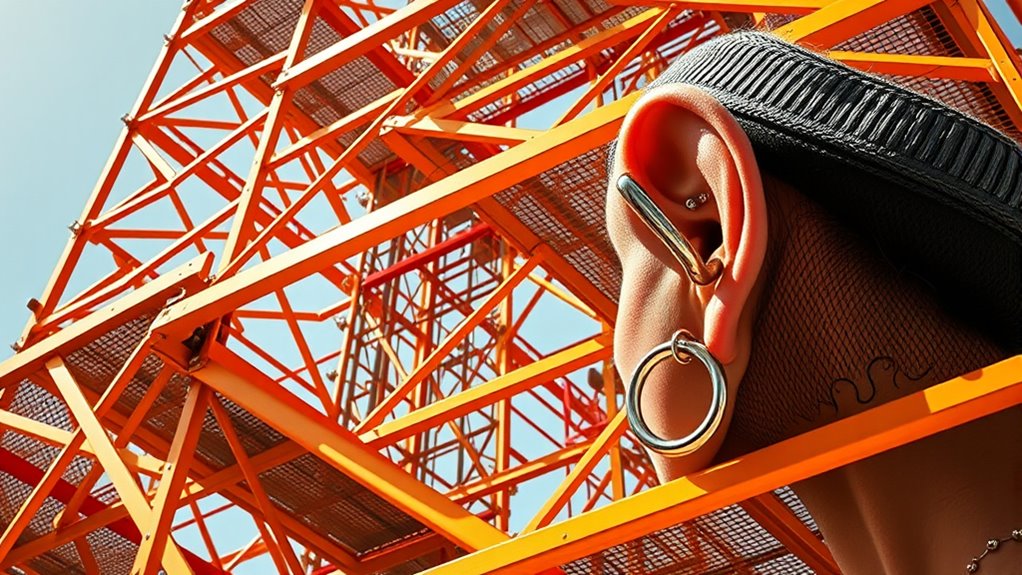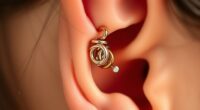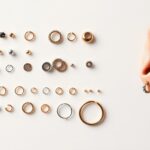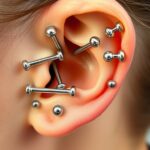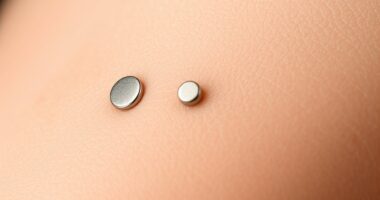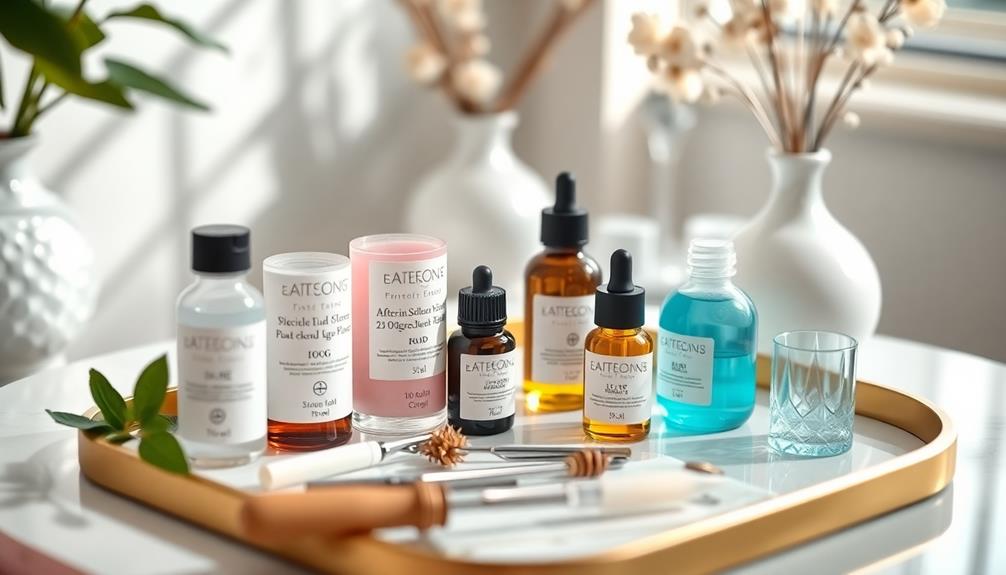Creative scaffold and industrial piercing designs let you stand out with bold, intricate body art that showcases your individuality. By combining multiple piercings connected with bars, you can craft unique patterns and striking visual effects. These designs are a creative way to express yourself, but they require careful planning, proper technique, and good aftercare. If you want to explore more about creating stunning, personalized industrial piercings, there’s plenty more to discover below.
Key Takeaways
- Incorporate bold, unique patterns and asymmetrical placements to create visually striking scaffold and industrial piercing designs.
- Use colorful or themed jewelry to enhance the creative and personalized appearance of the piercings.
- Combine multiple piercings with innovative connection styles for complex, eye-catching arrangements.
- Incorporate artistic elements like geometric shapes or thematic motifs into the piercing layout.
- Collaborate with professional piercers to develop custom designs that reflect individual style and artistic expression.
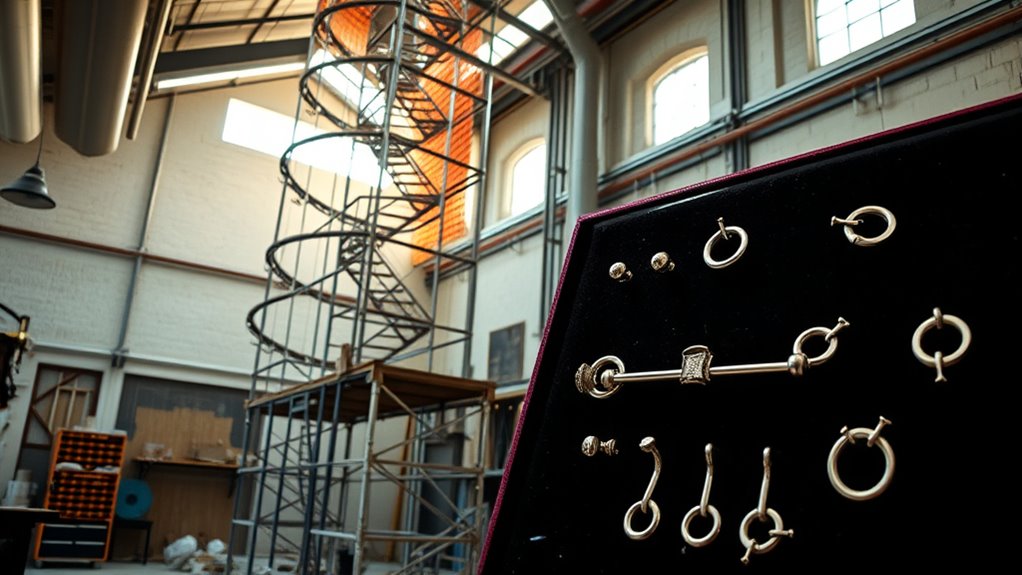
If you’re looking to stand out with bold body art, creative scaffold and industrial piercing designs offer a unique way to express yourself. These piercing styles are more than just accessories; they’re statements of individuality that can turn heads and spark conversations. But before you dive in, it’s vital to understand the risks involved and what the healing process entails. Both scaffold and industrial piercings involve multiple punctures, often connecting two or more points, which can make them particularly striking but also more prone to complications if not done carefully.
One of the biggest concerns with these types of piercings is the potential for risky complications. Because they involve two holes connected by a single bar, there’s a higher chance of infection if proper hygiene isn’t maintained. The skin between the piercings is more susceptible to irritation and trauma, especially if you’re physically active or wear tight clothing that rubs against the jewelry. Additionally, there’s a risk of migration or rejection, where the body pushes out the jewelry, especially if the piercing isn’t performed correctly or if incompatible materials are used. The complex nature of scaffold and industrial designs means there’s also a higher chance of nerve damage or scarring if the piercings aren’t placed precisely. Choosing an experienced piercer who understands anatomy and sterile techniques is vital to minimize these risks.
The healing process for scaffold and industrial piercings can be longer and more involved than standard piercings. Typically, it takes anywhere from six to nine months for full healing, though some may experience longer durations. During this time, you need to be vigilant about cleaning the piercings regularly with a saline solution to prevent infection. Swelling, tenderness, and crusting are common in the initial weeks, but if these symptoms persist or worsen, you should consult a professional. Because these piercings are more complex, they require more careful aftercare, including avoiding trauma or pressure on the jewelry. You’ll need patience and diligence to guarantee proper healing, as neglecting these steps can lead to complications like hypertrophic scarring or prolonged discomfort. It’s also essential to consider proper aftercare practices to promote healing and reduce risks. Remember, every body heals differently, so listen to your body and seek professional advice if you notice any unusual changes.
Ultimately, creative scaffold and industrial piercings are a bold choice that can showcase your personality and style. But understanding the risks and committing to diligent aftercare will help you navigate the healing process successfully. With proper precautions, you can enjoy your unique body art while minimizing potential setbacks.
Frequently Asked Questions
What Safety Precautions Are Necessary for Industrial Piercing Procedures?
You need to follow strict hygiene standards and use sterilized piercing equipment to guarantee safety during industrial piercing procedures. Always wash your hands thoroughly, wear disposable gloves, and clean the client’s skin properly. Make sure the piercer uses single-use needles and sterilized tools. Maintaining a sterile environment minimizes the risk of infection and complications. Following these precautions guarantees a safer experience for both you and your client.
How Long Does It Typically Take for a Creative Scaffold Tattoo to Heal?
A creative scaffold tattoo typically takes about 2 to 4 weeks to heal, but this can vary depending on your healing timeline and tattoo aftercare. During this period, you should keep the area clean, avoid picking at scabs, and follow your artist’s aftercare instructions closely. Proper tattoo aftercare ensures faster healing and vibrant results, so give your skin the attention it needs for ideal healing.
Are There Any Special Aftercare Tips for Unique Industrial Piercings?
To care for your unique industrial piercing, focus on proper piercing jewelry maintenance and infection prevention. Clean the area twice daily with saline solution, avoiding harsh chemicals. Avoid touching or twisting the jewelry, and steer clear of swimming pools or hot tubs during healing. Keep hair away from the piercing to prevent irritation. By following these tips, you’ll minimize infection risks and guarantee your industrial piercing heals smoothly.
Can Creative Scaffold Designs Be Customized for Individual Preferences?
Absolutely, you can customize scaffold designs to match your preferences. Coincidences happen often when you see scaffold design trends, inspiring you to personalize your piercings. By working with a skilled piercer, you can tweak elements like shape, materials, or placement, making your industrial piercing uniquely yours. Customizing piercings guarantees your jewelry reflects your style, and the latest trends help guide your choices for a truly personalized look.
What Materials Are Best for Durable and Safe Industrial Piercings?
For durable and safe industrial piercings, you should choose high-quality metal alloys like surgical-grade stainless steel, titanium, or niobium. These implant materials are biocompatible, reducing the risk of allergic reactions and infections. Titanium, in particular, is lightweight and highly resistant to corrosion, making it ideal for long-lasting piercings. Always guarantee your piercer uses reputable materials to keep your piercing safe and healthy.
Conclusion
Don’t hesitate to explore these creative scaffold and industrial piercing designs; they’re a bold way to express yourself. Some might worry about the pain or durability, but with proper aftercare and a skilled piercer, your unique look can last and heal beautifully. Embrace the artistry and individuality these designs offer. After all, personal style is about pushing boundaries and making a statement—so go ahead, turn heads and showcase your daring spirit.

